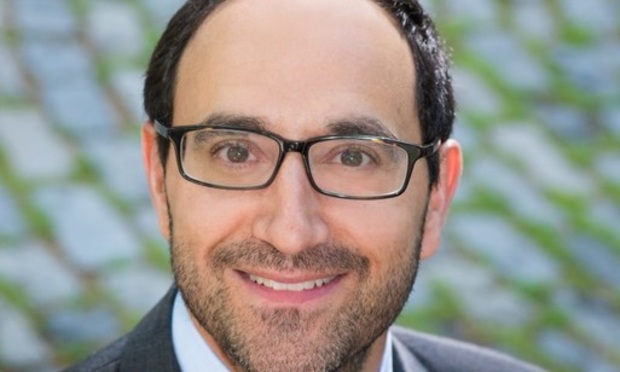For Those Experiencing Homelessness, COVID-19 Is Particularly Scary
COVID-19 is here. As I write this, New York City is besieged by cases of people sickened by the virus, and Philadelphia, recently designated a hot spot, is bracing for a potential onslaught. For many of us, this means hunkering down even more, often with loved ones, in the comfort and safety of our own homes.
April 17, 2020 at 01:56 PM
7 minute read
 Michael Taub, Homeless Advocacy Project
Michael Taub, Homeless Advocacy Project
COVID-19 is here. As I write this, New York City is besieged by cases of people sickened by the virus, and Philadelphia, recently designated a hot spot, is bracing for a potential onslaught. For many of us, this means hunkering down even more, often with loved ones, in the comfort and safety of our own homes. That is not an option for Homeless Advocacy Project's (HAP) clients, who are more likely to suffer from underlying health conditions than the general population but whose access to supportive services is now more limited than ever. HAP's current challenge is advocating for our clients in an overburdened environment where homeless service providers and city officials continue to work on the front lines of the epidemic.
For people experiencing homelessness, the threat of COVID-19 is particularly frightening. Whether sleeping outside or in shelter, conditions for eating, sleeping and socializing are cramped, even in the best of times. Shelter residents eat together, usually cafeteria style, and often sleep in rooms with multiple cots or bunk beds. For those who live outside, conditions can be just as tight, in overcrowded tents or under cardboard boxes, as they sleep and eat within feet or even inches of each other's faces.
Given these conditions, COVID-19 poses new and extraordinarily dangerous risks to those experiencing homelessness. The Centers for Disease Control and Prevention (CDC) recognizes these risks, and has provided guidance to help protect the health and well-being of people living in congregate shelters and those living outside, many of whom live in encampment communities.
With regard to shelters, the CDC provides guidance to help keep the virus out of shelters; and limit its spread within a shelter once a resident is known or believed to be infected with the virus. Both are monumental tasks. To keep the virus from infiltrating shelters, the CDC's recommendations focus on educating shelter residents about COVID-19 and making sure that shelters provide residents with enough supplies for maintaining proper hygiene, including highly coveted hand sanitizer and masks.
Once COVID-19 is known to have infiltrated a shelter, the CDC guidance shifts its focus to physical distancing. This presents challenges. Shelters are congregate settings where it is nearly impossible to create the kind of space between residents that the CDC recommends. For example, the CDC recommends spacing beds six feet apart. But increasing space between beds can mean fewer beds overall. The CDC also recommends confining residents with respiratory symptoms to individual rooms, but most shelters are short on individual rooms, especially if multiple residents are showing signs of infection.
Fortunately, Philadelphia is now operating a quarantine site at the Holiday Inn on Walnut Street in Center City. Residents of this facility—where a HAP paralegal is helping with intake—have either tested positive for or have symptoms consistent with the virus. Medical approval is required to secure a space, and anyone admitted cannot, under any circumstances, leave their room for 14 days. If they do, they will not be allowed back in. The city is also contemplating additional quarantine sites in the event that the Holiday Inn runs out of space.
The CDC guidance also recognizes that people living in such close quarters are likely to feel increased "mental strain" so long as COVID-19 remains an active threat in the community. However, the CDC also understands that many shelters do not have mental health professionals on staff, and that even for those that do, staff absences and physical distancing can make it difficult for residents to seek treatment. Even telehealth is not a viable option for most shelter residents.
For those living outside, the challenges are just as real and scary as for those in shelter. While the CDC recognizes that in some cases living outdoors may allow people more physical space and distance than those in shelters, it also recognizes that a sizable number live in small tents or cardboard boxes as part of an encampment community. For those living in tents, there may be two or even three people sleeping and eating in a single tent that is no bigger than the inside of a small car. Under these circumstances, it is not hard to imagine a scenario wherein COVID-19 quickly spreads through an entire encampment community, much as it has several nursing homes around the country. For this reason, the CDC is wise to have issued guidance specifically pertaining to people experiencing unsheltered homelessness.
Much like its guidance for people staying in shelter, the CDC's guidance pertaining to people experiencing unsheltered homelessness focuses on physical distancing and hygiene. In its guidance, the CDC recommends that people living in encampments sleep at least 12 feet x 12 feet from any other resident—a formidable task when not everyone living in the encampment can afford their own tent and most tents are meant to accommodate only one or two people. The CDC also recommends that cities ensure nearby 24-hour-a-day bathroom access, and that restrooms be equipped with sufficient soap or hand sanitizer, paper towels and bath tissue.
Most importantly, the CDC's guidance provides that unless individual housing units are immediately available for people living outside, cities should not "clear encampments during community spread of COVID-19." According to the guidance, clearing an encampment during this time can result in people fanning out among the larger community, which increases the likelihood of spreading the virus. Even so, Philadelphia officials chose to clear the encampment outside the convention center on March 23, in clear contravention of CDC guidance and a full week after Philadelphia had closed all but essential services. As with all prior encampment closures, HAP was on site to make sure that individuals were offered services and peoples' belongings were not destroyed.
The encampment clearing is but one example of HAP keeping an eye on the city's efforts to contain COVID-19 for those residents experiencing homelessness. As we navigate ways to engage in ongoing representation of our clients, we have to find creative ways of staying in touch. Most clients have limited minutes on their phones and no computer access. In addition, many now have limited access to shelter staff, who normally facilitate critical attorney/client communications, but who are currently (and understandably) distancing themselves from shelter residents. Many of our clients are also unable to maintain regular contact with their behavioral health case managers, who HAP staff heavily rely on when representing clients with serious mental illness. Even the process of ensuring our clients' access to stimulus rebates involves overwhelming obstacles in this environment.
COVID-19 has presented all of us with new challenges, and we are working to protect the health and safety of everyone, including those experiencing homelessness. Now more than ever, we cannot turn away from those without housing, no matter how out of sight they are or how challenging protecting them from COVID-19 may seem. At HAP, we will continue to look out for our friends experiencing homelessness. We will follow the virus' path as we work to ensure that city officials follow CDC guidelines until COVID-19 is no longer a threat to the health and safety of Philadelphians who don't have a place to call home.
Michael Taub is a staff attorney and director of The Homeless Advocacy Project's veterans project, where he has worked since 2003. He represents homeless veterans on their claims and appeals for VA benefits, and supervises pro bono attorneys who volunteer to represent homeless veterans on their VA claims and appeals.
This content has been archived. It is available through our partners, LexisNexis® and Bloomberg Law.
To view this content, please continue to their sites.
Not a Lexis Subscriber?
Subscribe Now
Not a Bloomberg Law Subscriber?
Subscribe Now
NOT FOR REPRINT
© 2025 ALM Global, LLC, All Rights Reserved. Request academic re-use from www.copyright.com. All other uses, submit a request to [email protected]. For more information visit Asset & Logo Licensing.
You Might Like
View All


Best Practices for Conducting Workplace Investigations: A Legal and HR Perspective
9 minute readTrending Stories
- 1We the People?
- 2New York-Based Skadden Team Joins White & Case Group in Mexico City for Citigroup Demerger
- 3No Two Wildfires Alike: Lawyers Take Different Legal Strategies in California
- 4Poop-Themed Dog Toy OK as Parody, but Still Tarnished Jack Daniel’s Brand, Court Says
- 5Meet the New President of NY's Association of Trial Court Jurists
Who Got The Work
J. Brugh Lower of Gibbons has entered an appearance for industrial equipment supplier Devco Corporation in a pending trademark infringement lawsuit. The suit, accusing the defendant of selling knock-off Graco products, was filed Dec. 18 in New Jersey District Court by Rivkin Radler on behalf of Graco Inc. and Graco Minnesota. The case, assigned to U.S. District Judge Zahid N. Quraishi, is 3:24-cv-11294, Graco Inc. et al v. Devco Corporation.
Who Got The Work
Rebecca Maller-Stein and Kent A. Yalowitz of Arnold & Porter Kaye Scholer have entered their appearances for Hanaco Venture Capital and its executives, Lior Prosor and David Frankel, in a pending securities lawsuit. The action, filed on Dec. 24 in New York Southern District Court by Zell, Aron & Co. on behalf of Goldeneye Advisors, accuses the defendants of negligently and fraudulently managing the plaintiff's $1 million investment. The case, assigned to U.S. District Judge Vernon S. Broderick, is 1:24-cv-09918, Goldeneye Advisors, LLC v. Hanaco Venture Capital, Ltd. et al.
Who Got The Work
Attorneys from A&O Shearman has stepped in as defense counsel for Toronto-Dominion Bank and other defendants in a pending securities class action. The suit, filed Dec. 11 in New York Southern District Court by Bleichmar Fonti & Auld, accuses the defendants of concealing the bank's 'pervasive' deficiencies in regards to its compliance with the Bank Secrecy Act and the quality of its anti-money laundering controls. The case, assigned to U.S. District Judge Arun Subramanian, is 1:24-cv-09445, Gonzalez v. The Toronto-Dominion Bank et al.
Who Got The Work
Crown Castle International, a Pennsylvania company providing shared communications infrastructure, has turned to Luke D. Wolf of Gordon Rees Scully Mansukhani to fend off a pending breach-of-contract lawsuit. The court action, filed Nov. 25 in Michigan Eastern District Court by Hooper Hathaway PC on behalf of The Town Residences LLC, accuses Crown Castle of failing to transfer approximately $30,000 in utility payments from T-Mobile in breach of a roof-top lease and assignment agreement. The case, assigned to U.S. District Judge Susan K. Declercq, is 2:24-cv-13131, The Town Residences LLC v. T-Mobile US, Inc. et al.
Who Got The Work
Wilfred P. Coronato and Daniel M. Schwartz of McCarter & English have stepped in as defense counsel to Electrolux Home Products Inc. in a pending product liability lawsuit. The court action, filed Nov. 26 in New York Eastern District Court by Poulos Lopiccolo PC and Nagel Rice LLP on behalf of David Stern, alleges that the defendant's refrigerators’ drawers and shelving repeatedly break and fall apart within months after purchase. The case, assigned to U.S. District Judge Joan M. Azrack, is 2:24-cv-08204, Stern v. Electrolux Home Products, Inc.
Featured Firms
Law Offices of Gary Martin Hays & Associates, P.C.
(470) 294-1674
Law Offices of Mark E. Salomone
(857) 444-6468
Smith & Hassler
(713) 739-1250






